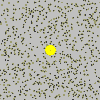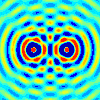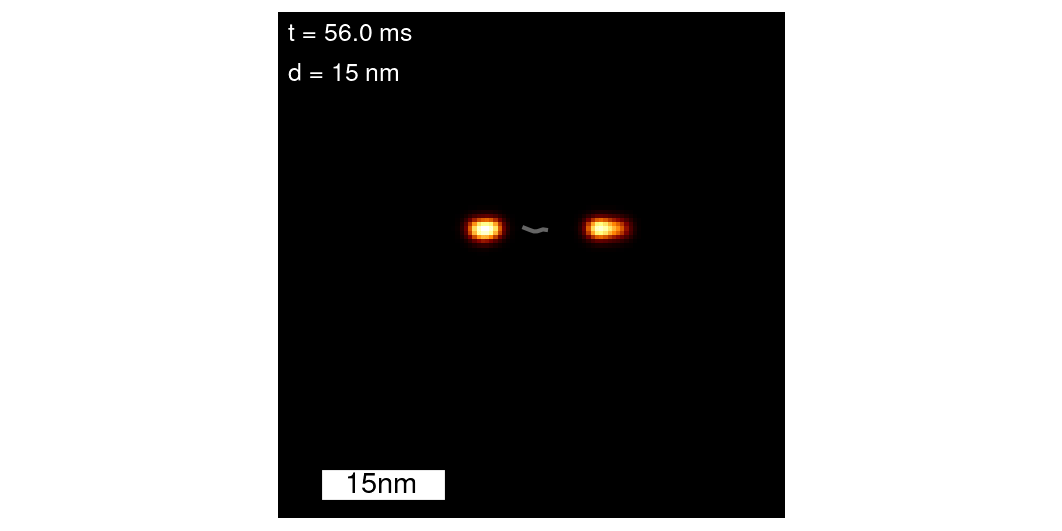publications
publications by categories in reversed chronological order. generated by jekyll-scholar.
2025
- Diffraction minima resolve point scatterers at few hundredths of the wavelengthThomas Hensel, Jan O. Wirth, Ole L. Schwarz, and 1 more authorJan 2025
Resolving two or more constantly scattering identical point sources using freely propagating waves is limited by diffraction. Here we show that, by illuminating with a diffraction minimum, a given number of point scatterers can be resolved at distances of small fractions of the wavelength. Specifically, we identify an 8 nm distance, which corresponds to 1/80 of the employed 640 nm wavelength, between two constantly emitting fluorescent molecules in the focal plane of an optical microscope. We also measure 22 nm side length for a quadratic array of four molecules. Moreover, we show that the measurement precision improves with decreasing distance and with increased scatterer density. This work opens up the prospect of resolving individual scatterers in clusters that are far smaller than the wavelength.
@article{Hensel2025, title = {Diffraction minima resolve point scatterers at few hundredths of the wavelength}, url = {https://www.nature.com/articles/s41567-024-02760-1}, doi = {10.1038/s41567-024-02760-1}, publisher = {Nature Physics}, author = {Hensel, Thomas and Wirth, Jan O. and Schwarz, Ole L. and Hell, Stefan W.}, year = {2025}, month = jan, google_scholar_id = {9yKSN-GCB0IC}, }
2024
- arXiv
 Decentralized Peer Review in Open Science: A Mechanism ProposalAndreas Finke, and Thomas HenselApr 2024
Decentralized Peer Review in Open Science: A Mechanism ProposalAndreas Finke, and Thomas HenselApr 2024Peer review is a laborious, yet essential, part of academic publishing with crucial impact on the scientific endeavor. The current lack of incentives and transparency harms the credibility of this process. Researchers are neither rewarded for superior nor penalized for bad reviews. Additionally, confidential reports cause a loss of insights and make the review process vulnerable to scientific misconduct. We propose a community-owned and -governed system that 1) remunerates reviewers for their efforts, 2) publishes the (anonymized) reports for scrutiny by the community, 3) tracks reputation of reviewers and 4) provides digital certificates. Automated by transparent smart-contract blockchain technology, the system aims to increase quality and speed of peer review while lowering the chance and impact of erroneous judgements.
@misc{https://doi.org/10.48550/arxiv.2404.18148, doi = {10.48550/ARXIV.2404.18148}, url = {https://arxiv.org/abs/2404.18148}, author = {Finke, Andreas and Hensel, Thomas}, keywords = {Computer Science and Game Theory (cs.GT), Computers and Society (cs.CY), General Economics (econ.GN), FOS: Computer and information sciences, FOS: Computer and information sciences, FOS: Economics and business, FOS: Economics and business, K.3.m; K.4.2; K.4.3}, title = {Decentralized Peer Review in Open Science: A Mechanism Proposal}, publisher = {arXiv}, year = {2024}, month = apr, copyright = {Creative Commons Attribution Non Commercial No Derivatives 4.0 International}, dimensions = {true}, google_scholar_id = {qjMakFHDy7sC}, } - BioarXiv
 Diffraction minima resolve point scatterers at tiny fractions (1/80) of the wavelengthThomas Hensel, Jan O. Wirth, and Stefan W. HellJan 2024
Diffraction minima resolve point scatterers at tiny fractions (1/80) of the wavelengthThomas Hensel, Jan O. Wirth, and Stefan W. HellJan 2024Discerning two or more identical and constantly scattering point sources using freely propagating waves is thought to be limited by diffraction. Here we show both theoretically and experimentally that by employing a diffraction minimum rather than a maximum for resolution, a given number of point scatterers can be discerned at tiny fractions of the employed wavelength. Specifically, we identify an 8 nm distance between two constantly emitting (non-blinking, non-switchable) fluorescent molecules, corresponding to 1/80 of the wavelength. Moreover, we show that contrary to naïve expectations, the measurement precision improves with decreasing distance between the scatterers and with increased scatterer density, thus opening up the prospect of resolving clusters of (optical) point scatterers at tiny fractions of the wavelength.
@article{Hensel2024, title = {Diffraction minima resolve point scatterers at tiny fractions (1/80) of the wavelength}, url = {http://dx.doi.org/10.1101/2024.01.24.576982}, doi = {10.1101/2024.01.24.576982}, publisher = {Cold Spring Harbor Laboratory}, author = {Hensel, Thomas and Wirth, Jan O. and Hell, Stefan W.}, year = {2024}, month = jan, google_scholar_id = {9yKSN-GCB0IC}, }
2022
- arXivSTE-QUEST: Space Time Explorer and QUantum Equivalence principle Space TestHolger Ahlers, Leonardo Badurina, Angelo Bassi, and 50 more authorsJan 2022
An M-class mission proposal in response to the 2021 call in ESA’s science programme with a broad range of objectives in fundamental physics, which include testing the Equivalence Principle and Lorentz Invariance, searching for Ultralight Dark Matter and probing Quantum Mechanics.
@misc{https://doi.org/10.48550/arxiv.2211.15412, doi = {10.48550/ARXIV.2211.15412}, url = {https://arxiv.org/abs/2211.15412}, author = {Ahlers, Holger and Badurina, Leonardo and Bassi, Angelo and Battelier, Baptiste and Beaufils, Quentin and Bongs, Kai and Bouyer, Philippe and Braxmaier, Claus and Buchmueller, Oliver and Carlesso, Matteo and Charron, Eric and Chiofalo, Maria Luisa and Corgier, Robin and Donadi, Sandro and Droz, Fabien and Ecoffet, Robert and Ellis, John and Estève, Frédéric and Gaaloul, Naceur and Gerardi, Domenico and Giese, Enno and Grosse, Jens and Hees, Aurélien and Hensel, Thomas and Herr, Waldemar and Jetzer, Philippe and Kleinsteinberg, Gina and Klempt, Carsten and Lecomte, Steve and Lopes, Louise and Loriani, Sina and Métris, Gilles and Martin, Thierry and Martín, Victor and M\"{u}ller, Gabriel and Nofrarias, Miquel and Santos, Franck Pereira Dos and Rasel, Ernst M. and Robert, Alain and Saks, Noah and Salter, Mike and Schlippert, Dennis and Schubert, Christian and Schuldt, Thilo and Sopuerta, Carlos F. and Struckmann, Christian and Tino, Guglielmo M. and Valenzuela, Tristan and von Klitzing, Wolf and W\"{o}rner, Lisa and Wolf, Peter and Yu, Nan and Zelan, Martin}, keywords = {Space Physics (physics.space-ph), General Relativity and Quantum Cosmology (gr-qc), High Energy Physics - Experiment (hep-ex), High Energy Physics - Phenomenology (hep-ph), Quantum Physics (quant-ph), FOS: Physical sciences, FOS: Physical sciences}, title = {STE-QUEST: Space Time Explorer and QUantum Equivalence principle Space Test}, publisher = {arXiv}, year = {2022}, copyright = {Creative Commons Attribution 4.0 International}, dimensions = {true}, google_scholar_id = {d1gkVwhDpl0C} }
2021
- epjdInertial sensing with quantum gases: a comparative performance study of condensed versus thermal sources for atom interferometryThomas Hensel, S. Loriani, C. Schubert, and 7 more authorsThe European Physical Journal D, Mar 2021
Quantum sensors based on light pulse atom interferometers allow for measurements of inertial and electromagnetic forces such as the accurate determination of fundamental constants as the fine structure constant or testing foundational laws of modern physics as the equivalence principle. These schemes unfold their full performance when large interrogation times and/or large momentum transfer can be implemented. In this article, we demonstrate how interferometry can benefit from the use of Bose–Einstein condensed sources when the state of the art is challenged. We contrast systematic and statistical effects induced by Bose–Einstein condensed sources with thermal sources in three exemplary science cases of Earth- and space-based sensors.
@article{Hensel2021, title = {Inertial sensing with quantum gases: a comparative performance study of condensed versus thermal sources for atom interferometry}, volume = {75}, issn = {1434-6079}, url = {http://dx.doi.org/10.1140/epjd/s10053-021-00069-9}, doi = {10.1140/epjd/s10053-021-00069-9}, number = {3}, journal = {The European Physical Journal D}, publisher = {Springer Science and Business Media LLC}, author = {Hensel, Thomas and Loriani, S. and Schubert, C. and Fitzek, F. and Abend, S. and Ahlers, H. and Siemß, J.-N. and Hammerer, K. and Rasel, E. M. and Gaaloul, N.}, year = {2021}, month = mar, dimensions = {true}, google_scholar_id = {u5HHmVD_uO8C} }
1935
- Can Quantum-Mechanical Description of Physical Reality Be Considered Complete?A. Einstein*†, B. Podolsky*, and N. Rosen*Phys. Rev., New Jersey. More Information can be found here , May 1935
Albert Einstein receveid the Nobel Prize in Physics 1921 for his services to Theoretical Physics, and especially for his discovery of the law of the photoelectric effect
In a complete theory there is an element corresponding to each element of reality. A sufficient condition for the reality of a physical quantity is the possibility of predicting it with certainty, without disturbing the system. In quantum mechanics in the case of two physical quantities described by non-commuting operators, the knowledge of one precludes the knowledge of the other. Then either (1) the description of reality given by the wave function in quantum mechanics is not complete or (2) these two quantities cannot have simultaneous reality. Consideration of the problem of making predictions concerning a system on the basis of measurements made on another system that had previously interacted with it leads to the result that if (1) is false then (2) is also false. One is thus led to conclude that the description of reality as given by a wave function is not complete.
@article{PhysRev.47.777, title = {Can Quantum-Mechanical Description of Physical Reality Be Considered Complete?}, author = {Einstein, A. and Podolsky, B. and Rosen, N.}, journal = {Phys. Rev.}, location = {New Jersey}, volume = {47}, issue = {10}, pages = {777--780}, numpages = {0}, year = {1935}, month = may, publisher = {American Physical Society,}, doi = {10.1103/PhysRev.47.777}, url = {http://link.aps.org/doi/10.1103/PhysRev.47.777}, dimensions = {true}, google_scholar_id = {qyhmnyLat1gC}, }




